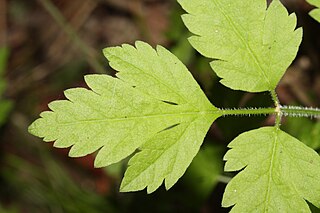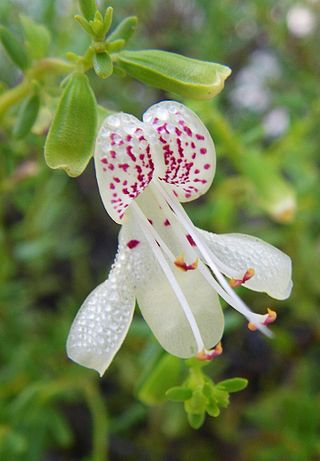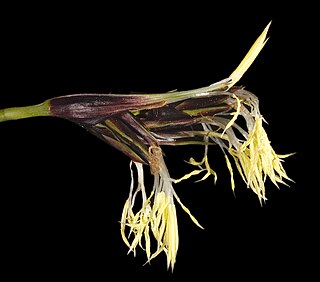
Agathis, commonly known as kauri or dammara, is a genus of evergreen coniferous trees, native to Australasia and Southeast Asia. It is one of three extant genera in the family Araucariaceae, alongside Wollemia and Araucaria. Its leaves are much broader than most conifers. Kauri gum is commercially harvested from New Zealand kauri.
Neotatea is a plant genus in the family Calophyllaceae. It is found in northwestern South America, primarily southern Colombia and Venezuela. There are four species currently recognized in the genus.

The rosids are members of a large clade of flowering plants, containing about 70,000 species, more than a quarter of all angiosperms.

Asteliaceae is a family of flowering plants, placed in the order Asparagales of the monocots.

Banksia subg. Spathulatae is a valid botanic name for a subgenus of Banksia. It was published in 2007 by Austin Mast and Kevin Thiele, and defined as containing all those Banksia species having spathulate (spoon-shaped) cotyledons. The name was published to accommodate forthcoming changes to the taxonomic arrangement of Banksia, based on the DNA sequence analyses of Austin Mast and others, which suggested a phylogeny for Banksia very greatly different from the accepted taxonomic arrangement. They found Banksia to be paraphyletic with respect to Dryandra, and that these two genera were best split into two clades, one with beaked follicles and non-spathulate cotyledons, the other with unbeaked follicles and spathulate cotyledons. Initially this clade was informally named "/Cryptostomata", in reference to the stomates, which are sunken with constricted entrances. Accordingly, in 2007 Mast and Thiele initiated a rearrangement by transferring Dryandra to Banksia, and publishing B. subg. Spathulatae for the species having spathulate cotyledons. The type species of Spathulatae was given as B. integrifolia, but no further details have been given. Mast and Thiele have foreshadowed publishing a full arrangement once DNA sampling of Dryandra is complete.
Mesostigma is a genus of unicellular biflagellate freshwater green algae, with a single species Mesostigma viride, covered by an outer layer of basket‐like scales instead of a cell wall. As of February 2022, AlgaeBase classified it as the only genus in the family Mesostigmataceae, the only family in the order Mesostigmatales, the only order in the class Mesostigmatophyceae. It is now considered to be one of the earliest diverging members of green plants/algae (Viridiplantae).

Osmorhiza berteroi is a species of flowering plant in the family Apiaceae known by the common name mountain sweet cicely.
Eosphagnum inretortum is a species of moss, and the only species of the genus Eosphagnum. Originally described as a species of Sphagnum, it is now a separate genus on the basis of morphological and genetic differences.

Dicerandra is a genus of flowering plants in the mint family. Dicerandra comprises 11 species: six perennial and five annual species. The perennials have narrow ranges in Central Florida with small population sizes and only occur on ancient dune ridges along the Lake Wales Ridge or the Atlantic coastal ridge; the annual species occur more broadly on sandhill habitats to the north. The perennials’ habitat has been severely fragmented due to human development over the past century. As a result, all perennial species except one are listed as federally endangered. Annual species of the clade have large ranges when compared to perennial members, with distributions of annuals ranging for hundreds of miles from the Panhandle of Florida to southeastern Georgia, with the exception of Dicerandra radfordiana which is endemic to two sites along the Altamaha river. The genus is characterized by hornlike spurs on their anthers.
Heliotropiaceae is a cosmopolitan family of flowering plants with approximately 450 species worldwide, though it is concentrated especially in the tropics and subtropics.
Ruppia megacarpa is a submerged herb species in the genus Ruppia found in shallow brackish waters. It is a common on Australasian coasts, including Australia (NSW; SA; Vic; WA and New Zealand. Isolated populations have been currently found in East Asia, including Japan, Korea, and Far East Russia, hence, the species distribution exhibit latitudinally disjunct distribution between East Asia and Australasia.

Splachnaceae is a family of mosses, containing around 70 species in 6 genera. Around half of those species are entomophilous, using insects to disperse their spores, a characteristic found in no other seedless land plants.
Dicerandra odoratissima, commonly known as the rose balm, is a species of Dicerandra native to the Southeastern Coastal Plain, with a geographic range that extends from eastern Georgia to southern South Carolina. Kral (1982) originally suggested that this species was so distinct from the remaining members of the genus that it should be placed in a separate section or a distinct genus. Today, D. odoratissima and its close relative D. radfordiana are members of the Lecontea clade.

Rhinantheae is a tribe with less than 20 genera of herbaceous plants in the family Orobanchaceae.

Tetraria is a genus of flowering plants in the sedge family, Cyperaceae, native to Tanzania, South Africa, Borneo, Australia and New Zealand.
Horovitzia cnidoscoloides is a plant species in the family Caricaceae, endemic to the cloud forest of Sierra de Juarez in Oaxaca, Mexico at elevations of 800 to 1600 meters. It is the only species in the genus Horovitzia. The type specimen was collected in Ixtlán de Juárez, Oaxaca in 9 March 1986

Hedbergia decurva, formerly Bartsia decurva, is a species of flowering plants in the family Orobanchaceae.
Hedbergia longiflora, formerly Bartsia longiflora, is a species of flowering plants in the family Orobanchaceae.

Selaginella deflexa, commonly known as deflexed spikemoss, is a non-flowering species of plant in the spikemoss genus Selaginella and is in the subgenus of the same name. It is closely related to Selaginella selaginoides which is the only other member in it's subgenus. It is endemic to Hawaii and grows primarily in the wet tropical biome from 1,050–1,500 m (3,440–4,920 ft). can be found on all major islands except for Lana'i. It is usually found growing in wet moss. Unlike most members of Selaginella,S. deflexa does not have rhizophores along it's stem. It gets its name from its reflexed leaves which point outwards.










